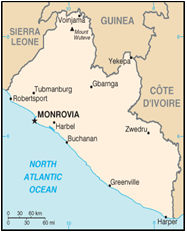- What We Do
- Agriculture and Food Security
- Democracy, Human Rights and Governance
- Economic Growth and Trade
- Education
- Ending Extreme Poverty
- Environment and Global Climate Change
- Gender Equality and Women's Empowerment
- Global Health
- Water and Sanitation
- Working in Crises and Conflict
- U.S. Global Development Lab
May 1, 2017
Food Security Situation

-
The Ebola epidemic in Liberia severely impacted the country’s health system, economy, and food security situation. Many households experienced new or increased food insecurity as Ebola-related fears and restrictions on movement and mass gatherings disrupted trade, increased food prices, and reduced household income and purchasing power. Although Liberia has been declared Ebola free, health organizations continue to monitor for flare-ups.
-
According to the Famine Early Warning Systems Network (FEWS NET), the main season for rice and cassava cultivation have started normally with forecasts for adequate rainfall predicted for the planting period between April and June 2017. This, combined with off-season harvest stocks, average import levels, and casual labor incomes, is expected to maintain Minimal (IPC Phase 1) food insecurity levels across the country through September 2017.
Food Assistance Programs
-
As recovery from the Ebola outbreak progresses and food security improves, the Office of Food for Peace (FFP) has phased out its recovery programming in Liberia. FFP continues to monitor the food security situation in Liberia.
-
During the Ebola epidemic, FFP partnered with the UN World Food Program (WFP), ACDI/VOCA, Mercy Corps, Project Concern International (PCI) Save the Children and UNICEF, to provide much needed food assistance to individuals, households, and communities affected by the Ebola epidemic. This assistance, comprised of a mix of targeted cash transfers, in-kind U.S. food commodities, locally and regionally procured food, and agricultural input vouchers, helped to boost food access, household purchasing power and market recovery.
-
FFP also supported FEWS NET during the Ebola response to increase food security monitoring and reporting in Liberia and Sierra Leone, assisting decision-makers to better respond to Ebola-related food insecurity. To document successes and lessons learned from the Ebola response, FFP supports research and learning initiatives through the Cash Learning Partnership (CaLP) in Liberia and Sierra Leone.
-
FFP also partnered with WFP to support Ivoirian refugees in refugee camps in Liberia through direct food assistance and livelihoods support as repatriation efforts to Cote d’Ivoire are underway. Once Liberia was declared Ebola-free, FFP supported WFP to provide in-kind food assistance to refugees during the repatriation process.
Food for Peace Contributions
Total Contributions:
| U.S. Dollars | Metric Tons | |
|---|---|---|
| Fiscal Year 2016 | $4.7 million | --- |
| Fiscal Year 2015 | $61.1 million | 16,995 MT |
| Fiscal Year 2014 | $20.2 million | 4,370 MT |
| Fiscal Year 2013 | $17.7 million | 3,450 MT |
| Fiscal Year 2012 | $25.0 million | 17,380 MT |
Fiscal Year 2016 Contribution Breakdown:
| U.S. Dollars | Metric Tons | |
|---|---|---|
| Title II Development | --- | ---- |
| Title II Emergency | --- | --- |
| Emergency Food Security Program (EFSP) | $4.7 million | --- |
Food Security Situation information is provided by FEWS NET and WFP







Comment
Make a general inquiry or suggest an improvement.